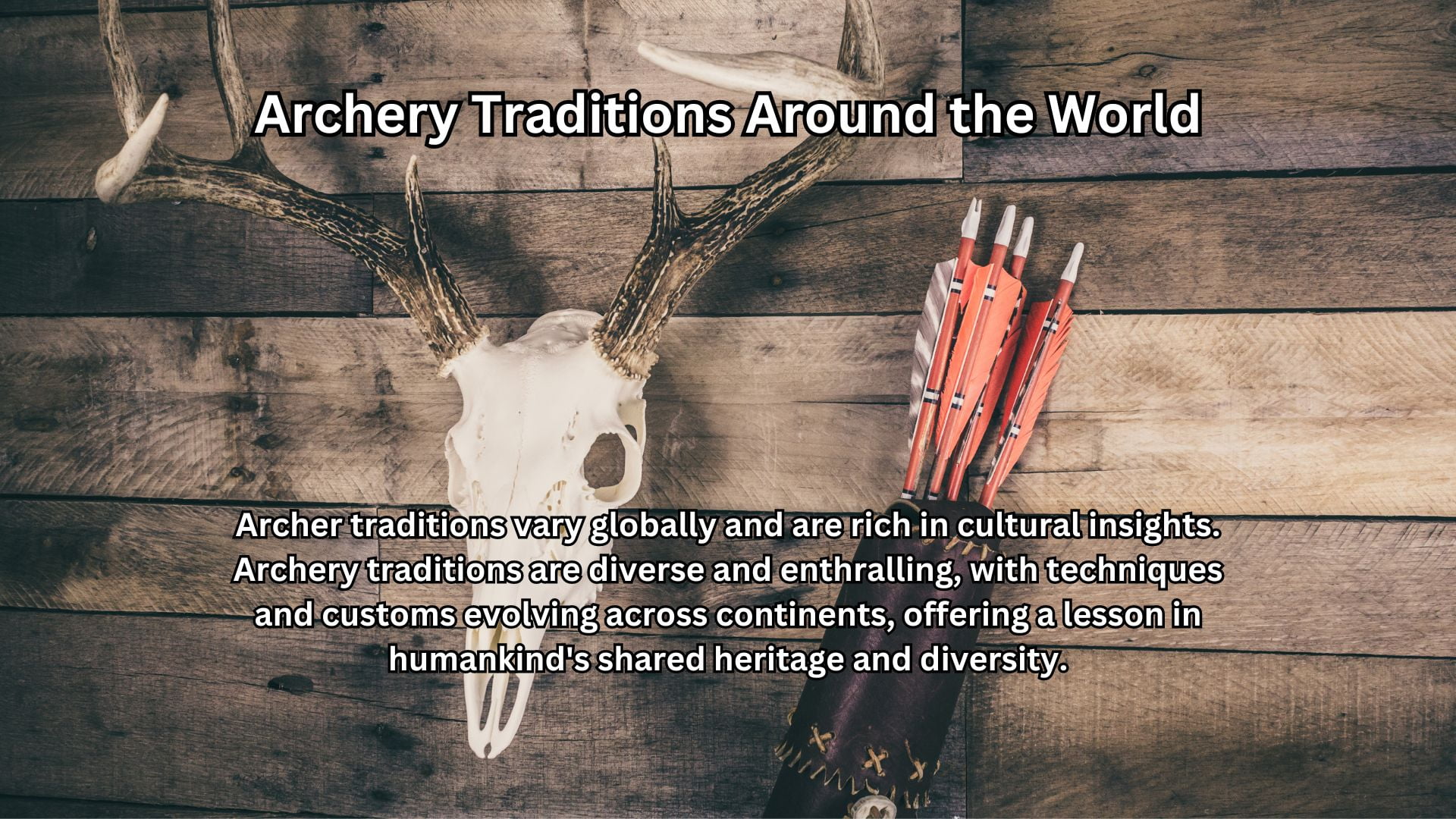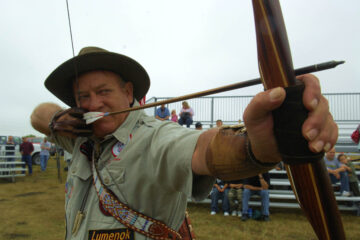Archer traditions vary globally and are rich in cultural insights. Archery traditions are diverse and enthralling, with techniques and customs evolving across continents, offering a lesson in humankind’s shared heritage and diversity.
Archery In Native American Cultures
It has been a significant part of many Native American cultures, with rich traditions and rituals surrounding its use. Here’s an overview of the different tribes and nations that had archery traditions, the historical significance of bows and arrows in native american cultures, and specific traditions and rituals surrounding archery in different tribes.
Overview Of The Different Tribes And Nations That Had Archery Traditions
- Native American cultures that had archery traditions include the Apache, Comanche, Cheyenne, Navajo, Sioux, and many more.
- Each tribe had its own unique styles and designs for their bows and arrows, ranging from simple to elaborate.
- Archery was used for hunting, warfare, and ceremonial purposes.
Historical Significance Of Bows And Arrows In Native American Cultures
- Bows and arrows were crucial tools for survival, as they provided a more efficient way of hunting and fighting.
- In many tribes, the creation of bows and arrows was considered a sacred craft, and there were often special rituals and ceremonies associated with their creation.
- The use of bows and arrows also played a significant role in native american mythology and storytelling.
Specific Traditions And Rituals Surrounding Archery In Different Tribes
- The Apache used a specific type of bow called the “short bow,” which was perfect for use on horseback.
- The Comanche were skilled archers and had a unique way of capturing wild horses by using bows and arrows.
- The Navajo used a specific type of bow made from juniper wood, and it was believed that the arrows should never be shot at the clouds or sun.
- In the Sioux culture, young men would participate in archery competitions as a way of demonstrating their bravery and skill.
- There were also many ceremonial uses of archery, such as in the “arrow dance” of the Cheyenne tribe, where the dancers would shoot arrows into the ground to symbolize their connection with the earth.
Overall, archery played a significant role in the cultures and traditions of many native american tribes. It was not just a tool for hunting and warfare but also a sacred art form and a way of connecting with the spiritual world.
Archery In East Asian Cultures
Archery has a rich history in east asian cultures, particularly in China, Japan, and Korea. In this section, we’ll be exploring the significance of archery in each of these countries, their specific techniques, and schools of archery.
Overview Of The Role Of Archery In Chinese, Japanese, And Korean Cultures
- In China, archery has a significant place in its history, as it was commonly used in warfare for thousands of years. It was also considered a symbol of state and a way of displaying military dominance.
- In Japan, archery, also known as kyudo, is considered a martial art and meditation practice. It is viewed as a way of developing self-discipline, strength, and focus.
- In Korea, archery, or gungdo, is considered a traditional martial art and is still widely practiced today. It was also used in warfare and has a rich history that dates back to the early dynasties.
Historical Significance Of Archery In East Asia
- Archery was an essential military skill in ancient China and played a key role in unifying the country under emperor qin shi huangdi. It was also featured heavily in ancient literature and art, showcasing its importance in Chinese culture.
- Japan’s samurai warriors practiced archery as a part of their training and in battle. It was viewed as a prestigious skill, and many samurai were known for their exceptional archery skills.
- Korea’s history is also deeply rooted in archery, as it was used in battle and considered a symbol of the nation’s cultural identity. It was also believed to have spiritual powers that could bring good luck and prosperity to the country.
Specific Techniques And Schools Of Archery In Different Countries
- In China, there are three main schools of archery: The northern school, the southern school, and the wubei school. Each school has its unique techniques and training methods.
- In Japan, kyudo has two main styles: The ceremonial and martial. The ceremonial style focuses on traditional forms and is often performed in cultural ceremonies. The martial style, on the other hand, focuses on technique and combat skills.
- Korea’s Gungdo has several schools, including the Songpa School, the Yun brothers school, and the Gyeongju Choi School. Each school has its unique philosophy and techniques.
Archery has played an essential role in east asian cultures for centuries and is still widely practiced today. It’s historical significance and specific techniques continue to captivate people around the world, making it a fascinating aspect of our shared human history.
Archery In African Cultures
Archery has been an integral part of African cultures for centuries. Different tribes across the large continent practiced archery for different reasons, including hunting, combat, and traditional sports. In this section, we’ll dive into the archery traditions of different African tribes.
Overview Of The Different Countries And Tribes In Africa That Had Archery Traditions
Archery traditions in Africa were prevalent in different parts of the continent. Here are some of the countries and tribes that embraced archery:
- Ethiopia: The Bana and Mursi tribes practiced archery using bows made from bamboo or animal bones.
- Namibia: The San tribe employed traditional archery methods with slight variations across different territories.
- Sudan: The Nubian, Zande, and Nuba tribes in Sudan were adept at archery and used it in warfare and religious rituals.
- Tanzania: The Hadzabe tribe is renowned for its proficiency in using bows and arrows in hunting.
Historical Significance Of Bow And Arrow In African Cultures
The bow and arrow were significant in African history, allowing tribes to hunt, defend themselves, and conquer territories. The use of bows and arrows dates back to ancient times, with evidence found in cave paintings and artifacts. The weapon became symbolic of bravery and skill and was used in many rituals, including traditional dances and ceremonies.
Specific Traditions And Rituals Surrounding Archery In Different Tribes
Archery held various meanings and was used for different reasons across different African tribes. Here are some specific practices:
- The Bana and Mursi tribes in Ethiopia believed that the strength and accuracy of the bow and arrow represented their courage and skill. Archery was used in traditional dances and marriage ceremonies.
- The San tribe in Namibia believed that shooting arrows would bring rain and prevent diseases. They even wore quivers throughout the day and carried bows and arrows most of the time for protection.
- The Nubian, Zande, and Nuba tribes in Sudan held archery in high regard and believed that a person’s archery skills determined their bravery and honor. Archery was used in festivals, funerals, weddings, and other important ceremonies.
- The hadzabe tribe in Tanzania used archery in hunting and regarded it as a rite of passage to adolescence. They employed stealth and agility in stalking and hunting animals, and archery was a common pastime among the men and boys.
Archery In European Cultures
Archery has been an integral part of European cultures since ancient times. From hunting to combat and modern-day sport, archery has evolved over the years. Let’s take a closer look at the different countries and regions in Europe that had archery traditions, their historical significance, and specific techniques and styles.
Overview Of The Different Countries And Regions In Europe That Had Archery Traditions
Archery traditions in Europe vary from region to region, and each country has its unique style. Here are some of the countries in Europe that have a history of archery traditions:
- England
- France
- Germany
- Italy
- Spain
- Scotland
- Scandinavia
- Russia
Historical Significance Of Archery In Europe
Archery played an essential role in European history. It was used for hunting, battle, and as a noble sport. Here are some key points on the history of archery in Europe:
- Archery was a crucial part of medieval warfare. Archers were used both on foot and horseback.
- Archery was a vital skill for knights, and many young nobles were trained in archery.
- In England, archery was mandatory, and all men were required to practice it. This practice was known as the “longbow law.”
- Archery became a popular sport in Europe in the 16th century.
Specific Techniques And Styles Of Archery In Different Countries
Each country in Europe has its unique style and techniques of archery. Here are some examples:
- In England, the traditional style is the longbow, which is made of yew wood.
- In France, the crossbow was a popular weapon of choice for both hunting and warfare.
- In Germany, the style of archery was more influenced by Eastern archery and cavalry tactics.
- In Italy, they focused on crossbows, and they were used widely in battles during the medieval period.
- In spain, the moors brought the tradition of archery, and it became an essential part of spanish culture.
- In scandinavia, the vikings used archery for hunting and battle.
- In russia, archery was widely used before the introduction of firearms.
Archery in europe has a rich history and diverse traditions that have evolved over time. Each country has its unique style and techniques, making archery an exciting sport that has continued to grow and evolve.
Frequently Asked Questions Of Archery Traditions Around The World: Insights From Different Cultures
What Is The History Behind Archery Traditions Around The World?
Archery is one of the oldest skills humans developed for hunting and warfare. Nearly every culture around the world has their take on archery traditions passed down over generations. Traditional archery is also a popular sport that emphasizes technique and accuracy.
What Are Some Unique Archery Traditions That Exist Today?
Some unique archery traditions still exist today, such as the japanese archery form of kyudo, which emphasizes form, mindfulness, and shooting at incredibly long distances. Another example is bhutanese archery, which features a form of competitive archery that often involves singing and colorful dress.
What Is The Significance Of Archery In Different Cultures?
In some cultures, such as Native Americans, archery was an essential survival tool for hunting and warfare. others, such as Japanese samurai culture, archery played a critical role in character development and mental focus. In many Asian cultures, archery was a sport and relaxation technique.
Do Archery Traditions Vary Based On A Person’S Gender?
In some archery traditions, such as kyudo, specific movements and forms are only reserved for men or women. In other cultures, like mongolia, both men and women take part in archery games, but the rules and scoring can vary. However, in many cases, archery is an equally accessible sport for all genders.
How Have Modern Technologies Impacted Archery Traditions?
Modern technologies have changed the field of archery with more advanced equipment available, such as improved compound bows and carbon fiber arrows. Some traditional archers embrace new technologies, but others prefer the simplicity and traditional methods of the practice that go back centuries.
Conclusion
After exploring various archery traditions around the world, it is clear that this age-old sport has played an important role in different cultures throughout history. Whether it is used for hunting, sport, or warfare, archery has evolved in unique ways in different parts of the world.
From the ancient persian empires to the native american tribes, we can see how archery has been passed down from generation to generation and deeply embedded in cultural practices. We have learned about the different styles of bows, arrows, and techniques used in traditional archery and how they have influenced modern-day archery.
And while these traditions may differ, the common thread is the respect and appreciation for the sport. By learning about these traditions, we can gain a deeper understanding of the importance of archery and appreciate the cultural significance it holds around the world.







